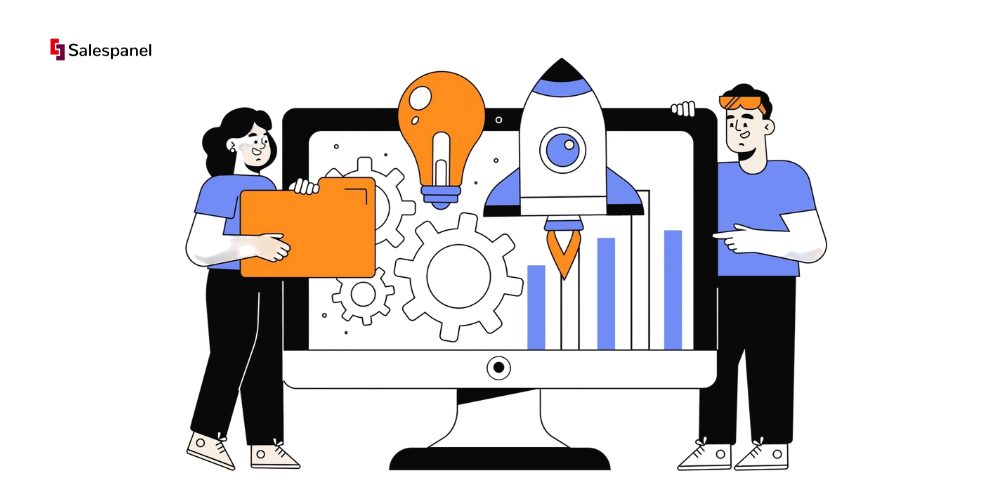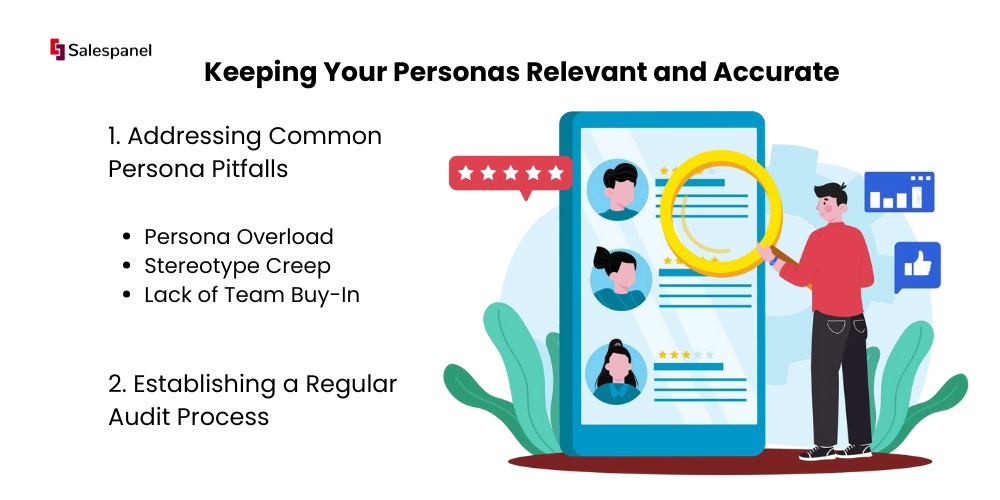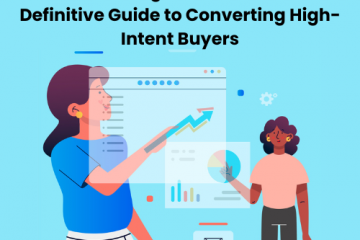How to Create Buyer Personas That Drive Growth – B2B Buyer Personas 2.0
In the past, personas were often fictional characters based on intuition. Today, it is dynamic, verifiable data, which has proven to transform business outcomes. A buyer persona is not just an abstract marketing exercise for marketing collateral; it’s a structure & data-driven process for modeling your ideal customer. Done correctly, it moves marketing and sales strategy from guesswork to a growth engine. If done right, it will move a marketing and sales strategy from being a point of conjecture to an engine of unprecedented growth. Organizations that thrive in marketing modernized around customer personas have enjoyed a 19% increase in revenue growth, along with a 14% climb in customer retention. This article aims to provide a technical framework for creating, implementing, and maintaining buyer personas that deliver measurable results so that the go-to-market strategy is aligned with a faceless industry, but about the actual people you need to serve. The focus of this document is to point out that actionable customer personas stem from customer data that is thoroughly vetted.
From Guesstimates to Growth Engines

Just a little while ago, buyer personas were little more than some made-up character dreamed up in the context of a corporate meeting. For Marketing teams, Marketing Mary and Sales Sam were characters designed based on internal assumptions and anecdotal evidence. This logic and methodology was a lofty cowboy approach, and put the company’s words in the wrong context – the messaging and campaigns never hit the bull’s eye.
Those educated guesses are now replaced with data-backed profiles that serve as the central nervous system for high-performing B2B teams. An effective persona is more than a document that is created and shelved; it is an active living profile made from real and verifiable data. This evolution closes the critical gap between what companies sell and what their customers actually want. The philosophy here is that understanding your customer is not a task to finish, but a continuous process of data collection and refinement, which is the ethos behind platforms like Salespanel that focus on real-time customer intelligence.
The Power of Data-Backed Personas

The effective profiles are backed up by data, and that forms the thesis of this guide. This data-first methodology provides a direct conduit into your customer’s professional world—their pain points, strategic objectives, and the decision-making criteria they employ. It helps you engage in thoughtful conversations rather than blurting out a generic message. It helps you formulate a strategy instead of resorting to broadcasting a message.
This represents a significant departure from historical practices where assumptions were the primary driver. Let’s analyse the technical differences.
Persona Development: Past vs Present
| Attribute | Traditional Approach (Guesswork) | Modern Approach (Data-Driven) |
|---|---|---|
| Foundation | Intuition, anecdotes, internal assumptions | Real customer interviews, CRM data, analytics |
| Process | Brainstorming sessions, creating fictional characters | Systematic research, data synthesis, and validation |
| Accuracy | Often biased and stereotypical | Reflects actual customer behaviors and needs |
| Application | Broad, generic messaging | Highly personalized content and sales outreach |
| Outcome | Misaligned campaigns, low engagement | Higher conversion rates, stronger customer fit |
Strategic value comes from the shift from the left column to the right. 90% of companies that employ buyer personas claim to better understand their customers. Statistical studies give weight to this shift. For smoother alignment of the sales, marketing, and product development arms of a business, align. Firms that actively maintain and refresh their Buyer Personas are far more likely to hit and exceed their lead and revenue goals. For a better understanding, you can look at the statistical impact of buyer personas and get the complete picture.
Buyer personas serve the technical function of transforming an abstract audience into a tangible, relatable human model. Focusing on whether it is “Data-Driven Dan” lets the Sales Team prepare for technical questions and narrow their focus on ROI, instead of executing a generic pitch. Like in the situation with Dan, where one of his challenges is data fragmentation, it allows a salesperson to lead with a discussion on API capabilities, immediately establishing relevance.
Specificity is what turns a marketing asset into a strategic tool for growth. It dictates the content developed, the platforms chosen for advertising, the order in which the Sales Team contacts prospects, and the features of the product that need to be developed first. Understanding the person being sold to is vital to make sure that every single interaction made matters and is more effective. This understanding of the customer is what modern marketing relies on, and it makes deriving proper personas a crucial technical skill.
Building the Data Foundation
You can’t construct an effective buyer persona solely on speculation. If you’re only brainstorming ideas in a conference room, you’re not developing a persona; you’re writing fiction. The goal is to move from assumption to evidence-based insight. This takes a systematic approach to data collection from various key sources.

Your first source of data is internal to the organisation and is the team you are a part of. Daily, the sales support and product departments perform front-line duties. They possess a deep, and often untapped, well of knowledge regarding customers. They hear feedback directly from the source on issues and problems, unmet needs, and problems solved by the product.
Tapping Internal Expertise
This needs more than an informal chat; there’s a need for more in-depth, concrete interviews. Which needs careful, focused, and specific questions, as open and vague questions get open and vague answers.
Your Sales Team:
- What are the free text responses most common questions customers/clients ask during a demo?
- What do you think the top 3 objections are that they encounter all the time?
- What are the titles in Closed Won Deals versus the titles in Stalled Deals?
Your sales team might report that deals with ‘Marketing Operations Managers’ close 30% faster than those with “Marketing Directors,” which might suggest that those are key target personas.
- Your Support Team: Examine the support tickets that come in the most frequently. What specific issues are customers attempting to solve just before they have a problem and ask for support? Are there any clear patterns regarding the user types that need the most help? For instance, you might discover that users with a certain tech stack create 50% of all tickets related to integrations, revealing a critical technical challenge for that segment.
- Your Product Team: What features get the most engagement? What user comments drove the last significant update to the product? Ask the users directly: “Who are the users for whom you are building these next features?”
This phase of the internal discovery phase gives you a qualitative foundation, which in turn helps you draft a puff of the customer profile and motivation for engagement in external research.
Gathering External and Quantitative Data

With internal narratives created, the next step is to test them with quantitative data and direct customer feedback. This binds what people say to what people do. An effective persona is born from a mix of market research, surveys, interviews, and analytics from tools like Google Analytics.
An example would be to segment geolocation and referral sources of website traffic in Google Analytics or in Salespanel for B2B visitor tracking to study the website conversion funnel of various user groups. This shows what they genuinely care about. To learn more about generating data-based buyer personas, visit magnolia-cms.com. The marriage of demographic information (the “who”) and psychographic information (the “why”) helps us construct a 360-degree profile.

“When it comes to user behavior, the most potent data comes from behavior, not from self-reporting.” Tracking the user journey is critical. In an interview, a customer may claim that customer support is the customer’s first and foremost concern. However, the data trail indicates the customer spent 20 minutes on the pricing page and read three competitor comparison articles before converting. In the interview, the user’s behavior tells a different, more reliable story focused on ROI and competitive positioning.
This is where a platform like Salespanel becomes your source of truth. It tracks which content, pages, or features a lead actually engages with, showing you their real interests and priorities as they happen. This behavioral data doesn’t just supplement your interview findings—it validates them, ensuring your personas are grounded in reality, not just well-meaning conversations.
With the combination of all these data streams—internal employee knowledge, data from interviews with customers, and customer behavior data analytics—the system gets to rest on a robust foundation. Your absence from the marketing and the product line personas will not be fictional characters, but true representations of your best customer.
Crafting Your Actionable Persona Profile

You’ve finished the research phase and now have a treasure trove of interviews, CRM reports, and behavioural data. Data by itself, however, is noise until you synthesise it into a coherent narrative. Your next goal is to put these insights together into a functional, actionable persona document.
This profile is not simply a summary; it is a strategic tool.
Refrain from using templates that contain irrelevant information, like personal hobbies. An actionable persona is built on factors that are critical to closing a sale. This is how company buyer personas are created to help business growth.
In order to maximise effectiveness, the persona should be built around four key pillars. This framework provides a comprehensive view of the customer’s professional environment, plus, and very importantly, how your solution fits within it.
- Goals: What do they aspire to accomplish in their role? What do they consider success for the organisation and for their own career in the long term? (ex. “Reduce manual reporting time a week for more important work.”)
- Challenges: What obstacles impede their progress? This includes daily operational frustrations and larger strategic problems. (e.g., “Data is fragmented across five different marketing platforms.”)
- Information Sources: Where do they go to get new information? They should be able to name specific blogs, industry publications, and professional networks. This becomes their digital watering holes. (ex. “Reads the MarketingProfs blog and participates in the MOPs Pros Slack group.”)
- Decision Drivers: What’s most important when assessing a new solution? ROI, ease of use, integration capabilities, and reputation of the vendor? (ex. “Must have a native integration with their CRM and have demonstrated ROI within the past 6 months.”)
Building a Practical Example
We will use this framework to develop a persona for ‘Data-Driven Dan’, who works as a Marketing Operations Manager at a mid-sized B2B tech company. He will be shaped around real information to turn his persona from abstract to concrete.

To begin, we analyse the CRM to assess its background. There is a pattern: the best customers we have in this role often work at SaaS companies with 100-500 employees. This firmographic information helps in providing context.
Subsequently, we have consolidated qualitative information from interviews with the customers. One manager said, “I spend half my week manually stitching together reports from five different platforms. I need a single source of truth, not more dashboards.”
I spend half my week manually stitching together reports from five different platforms. I need a single source of truth, not more dashboards.”
This direct quote is more telling than any generic statement. It precisely articulates Dan’s core challenge: data fragmentation and the resulting inefficient manual labor. This sentiment can be directly incorporated into his ‘Challenges’ section.
Finally, we add in insights from behaviour. With Salespanel, for example, we observe that leads matching Dan’s profile consistently download our ‘Ultimate Guide to Marketing Attribution.’ They also spend significant time on our integration features page. This specific profile will use a lot of time on the “Ultimate Guide to Marketing Attribution” as well as spend a lot of time on the page for our integration features.
This behavioural data reveals two key facts: he is highly analytical, and he places a high value on how a new solution will integrate with his existing technology stack.
By combining these data sources—CRM data for context, interview quotes for emotion, and behavioural analytics for validation—a complete profile emerges. ‘Data-Driven Dan’ is no longer just a job title. He is a professional with specific goals, real frustrations, and a clear evaluation process. This hands-on, data-centric approach is what transforms a collection of data points into a strategic asset that aligns your entire organisation.
Putting Your Personas to Work Across Go-To-Market Teams
A meticulously researched buyer persona is a powerful tool, but its value is realised only through activation. A document residing in a shared drive has no impact. The critical phase is activation – the stage whereby data-driven personas are used in the daily workflows of the go-to-market teams to transform insight into action.
Here is the point of execution. It means a fundamental shift from generic outreach for both marketing and sales to hyper-relevant engagement. There are different objectives in different interactions, and personalising over-researching the objectives will ensure effective personal interactions every time.
Aligning Marketing Content with Persona Journeys
Each stage of the buyer’s journey activates the persona and builds more effective interactions for the main component of the content. A more focused approach may be more beneficial than the generic eBook content. Instead of the eBook, consider an asset for ‘Data-Driven Dan’ that focuses on the challenge of data fragmentation.
This approach will attract more prospective customers.
- Awareness Stage: The title, “5 Technical Signs Your B2B Company Has Outgrown Manual Reporting,” will be more relevant and helpful than any generic content.
- Consideration Stage: The SaaS case studies will fit perfectly here, especially the one where a similar-sized SaaS company centralised its analytics. Reduce manual reporting time by 20 hours a week. If you show before and after examples, they will understand the impact of the reporting workflow.
- Decision Stage: A technical one-pager that compares your platform and your competitors on integration capabilities and features that matter to them the most. Native CRM sync and API access are examples of what one might focus on.
This approach helps ensure resources are used efficiently and have a meaningful impact. Content creation is now a solving solution, not a responding solution.
Equipping Sales with Persona-Driven Tactics
Combining the persona profile with a strategic brief for every customer encounter allows your sales team to use it at every step. It also allows them to tailor outreach scripts, contact and discovery questions, and product demonstrations to the prospect’s particular conditions. They can move away from a standard sales approach to one that demonstrates empathy, reserving the detailed technical information for a later time.
Let’s take an example. ‘Data Driven Dan’ is a potential customer. Rather than doing a feature dump, a sales rep can start a conversation like, ‘I noticed you downloaded our guide on marketing attribution. It seems like you spoke to a few of our competitors also. Many marketing ops managers we work with are struggling to unify their data sources. Is that a challenge for your team, as well?’
This type of opener is tailored, showing that you’ve done your research. The more personalisation you do, the more you will see an improvement in your key business metrics. It’s been proven that businesses that actively use marketing personas see a 14% improvement in customer retention, along with a 19% improvement in revenue. 36% of the companies using marketing personas have successfully reduced the length of their sales cycles. You can research more about the impact of buyer personas in your business to understand this powerful marketing concept fully, using the metrics provided.
Understanding the customer is only half the challenge. The other half is ‘activation’. Activation is the bridge that connects customer understanding to customer engagement. It is the difference between a cold call and a warm conversation.
Personalising the customer journey is powerful, and Salespanel makes this easy to put into action on your site. With the use of behavioral triggers, you can filter users based on persona criteria like what pages they looked at and what content they downloaded, and you can send targeted pop-ups or chat invitations. Instead of a static website, you have a conversation at a dynamically personalised level to significantly speed up the entire sales process.
For operational clarity, here is a matrix that shows how various teams can turn on the ‘Data-Driven Dan’ persona.
Persona Activation Matrix
| Business Function | Activation Tactic for “Data-Driven Dan” | Expected Outcome |
|---|---|---|
| Content Marketing | Create a detailed whitepaper on “The ROI of Unified Analytics Platforms.” | Attract high-intent leads who are actively researching solutions to data fragmentation. |
| Paid Advertising | Target ads on LinkedIn to users with the job title “Marketing Operations Manager” using visuals that feature dashboards and data charts. | Increase click-through rates and reduce cost per lead by showing highly relevant ad creative. |
| Sales Development | Reference a recent industry report on data integration challenges in the first email outreach. | Improve email open and reply rates by establishing immediate relevance and credibility. |
| Product Marketing | Develop a new feature one-pager that specifically highlights API capabilities and seamless integration with other tools. | Equip the sales team with collateral that directly addresses a key technical requirement for this persona. |
| Customer Success | During onboarding, proactively share best practices for connecting disparate data sources to the platform. | Increase user adoption and satisfaction by demonstrating a deep understanding of the customer’s primary use case. |
From the above example, a single, well-defined persona can create a ripple effect throughout the organisation, aligning all efforts and ensuring a consistent, customer-centric approach from initial contact to long-term partnership.
Keeping Your Personas Relevant and Accurate
Markets evolve. Customer priorities shift. A buyer persona created last year may be obsolete today.
Creating buyer personas is not a one-time project; it is an ongoing practice of refinement. The moment your personas cease to reflect the reality of your market, they lose their strategic value.
Every persona can be extremely well designed, but they can be outdated for a range of easily avoidable reasons.

Addressing Common Persona Pitfalls
High-performing marketing and sales organizations treat their personas as living documents. This requires vigilance against common issues that erode accuracy and utility.
- Persona Overload: Having an unreasonably large number of personas is erroneous, but also common. More is not better in this case, as it creates dilution. When a sales team must manage the nuances of a dozen profiles, they effectively master none. Focus on 1 to 3 core personas that are most valuable to customer segments.
- Stereotype Creep: Over time, profiles that are driven by data may become degraded caricatures. Using stereotypes like “Millennial Mark” instead of current, actual data makes your messaging obsolete and irrelevant. It is imperative to continually validate your assumptions with fresh research.
- Lack of Team Buy-In: This is an extremely important “point of failure.” If your sales and marketing personnel lack belief in the personas, they will not use them. The solution is to involve these teams directly in the creation and review process, ensuring the profiles accurately reflect their real-world interactions.
The unifying principle here is that a persona’s value is directly proportional to its accuracy. Maintaining accuracy requires a systematic process of auditing and refreshing.
A persona should function as a strategic guide, not a static document. When customer behavior changes, your persona must adapt accordingly. This proactive approach is a key differentiator for high-performing teams.
Establishing a Regular Audit Process
The best way to preserve personas is to have an audit cycle in place. My suggestion is to have an audit quarterly. This is not to say you need to make drastic changes, but rather this is a way for you to identify evolving customer profiles.
When evaluating this audit, make sure to check fresh data in your CRM system as well as data from your analytics tools. Are you seeing some of the new customers change the kinds of job titles they have? Are your best leads engaging with different types of content? These are early signs that a change is required.
This goes to prove that the philosophy of continuous validation strengthens your go-to-market strategy. For example, Salespanel is a platform that will notify you early when lead activity deviates from established persona profiles by tracking visitor behavior..
A case in point would be the case of a lead who is in your system as a Data-Driven Dan, who all of a sudden stops engaging with technical whitepapers and focuses exclusively on the pricing page. This is extremely valuable information. It probably indicates a market shift toward price sensitivity or a change in your competitive landscape.
This type of analysis helps you to understand the full, updated customer journey. It is the practice of constantly working on refining your personas, which in turn allows you to better your strategy. If you do not do this, your personas will quickly turn into obsolete, strategy relics.
Got Questions? We’ve Got Answers

Even a comprehensive guide can leave specific questions unanswered. Here are some of the most common technical questions about the creation and use of B2B buyer personas and straightforward, actionable answers.
How Many Buyer Personas Should We Really Have?
There is no universal number, but a core principle applies – quality trumps quantity. In B2B, the risk of trying to develop a persona for every single possible customer segment can get a bit confusing and lead to inaction.
Most B2B companies will get the best performance with between one and three core personas. Focus on identifying your most profitable and ideal customers first.
Trying to manage more than five personas dilutes of team’s focus. The profiles become harder to remember and are ignored in the end. A great starting point would be to use the 80/20 rule – Identify the 20% of customers who are responsible for 80% of your revenue. Once you develop a persona for that segment and achieve certain metrics, only then should you consider expanding.
What’s the Real Difference Between a Buyer Persona and an ICP?
This is one of the more common misunderstood distinctions, but it is critical to operations. Your Ideal Customer Profile (ICP) is different from a buyer persona, but they are both still related.
An Ideal Customer Profile assists with outlining a business. Buyer Persona defines the person within that company (title, responsibilities, goals, challenges, decision criteria)
- Ideal Customer Profile (ICP): This is a definition of the perfect company to target. It focuses on firmographics: industry, company size, annual revenue, geography, and technology stack. It dictates which accounts to target. For example, an ICP might be “US-based SaaS companies with 100-500 employees and annual revenue of $10M-$50M.”
- Buyer Persona: This provides a detailed profile of the individual decision-maker or influencer within that ideal company. It focuses on demographics and psychographics: their job title, responsibilities, goals, challenges, and decision-making criteria.
Use ICP to build a target account list, then use buyer personas to craft tailored messaging for key individuals. Outreach account engagement drastically changes with personalisation as compared to spam.
A significant budget is not required to create effective personas. In reality, within your enterprise, the most effective, insightful data is available completely free.
Start with your sales and customer service teams. They are a primary source of qualitative data, engaging with your clients and noting down their issues and motivations every day.
Then, look through your data. Your CRM and Google Analytics contain a wealth of behavioural patterns. For example, analysing the most common conversion funnel for your best customers and what actions lead to their successes, what steps are necessary to streamline their conversion processes, what other fundamental gaps need to be met to address their core concerns, and wrapping up necessary ideas and insights.
“Moving forward with your customer interviews, your target customer set does not need to be extensive. From my experience, 5 to 10 interviews with your top customers is the range in which you can reach saturation, in terms of the qualitative data you can extract. Often, a small gift (gift card, etc.) serves as a nice incentive. 5–10 in-depth interviews with your best customers provide rich qualitative narratives that bring a persona to life, of in-depth data that these qualitative interviews extract.”
Are you ready to stop making assumptions and base your marketing efforts on actual customer behavior? With Salespanel, you can stop making assumptions – identify, track, and learn from your website visitors. Start creating – data-backed personas. Salespanel helps you identify, track, and understand website visitors so you can build personas that actually work.
We hope that you liked this write-up. If you have any questions or feedback, please let us know through our support channel.
Sell more, understand your customers’ journey for free!
Sales and Marketing teams spend millions of dollars to bring visitors to your website. But do you track your customer’s journey? Do you know who buys and why?
Around 8% of your website traffic will sign up on your lead forms. What happens to the other 92% of your traffic? Can you identify your visiting accounts? Can you engage and retarget your qualified visitors even if they are not identified?


